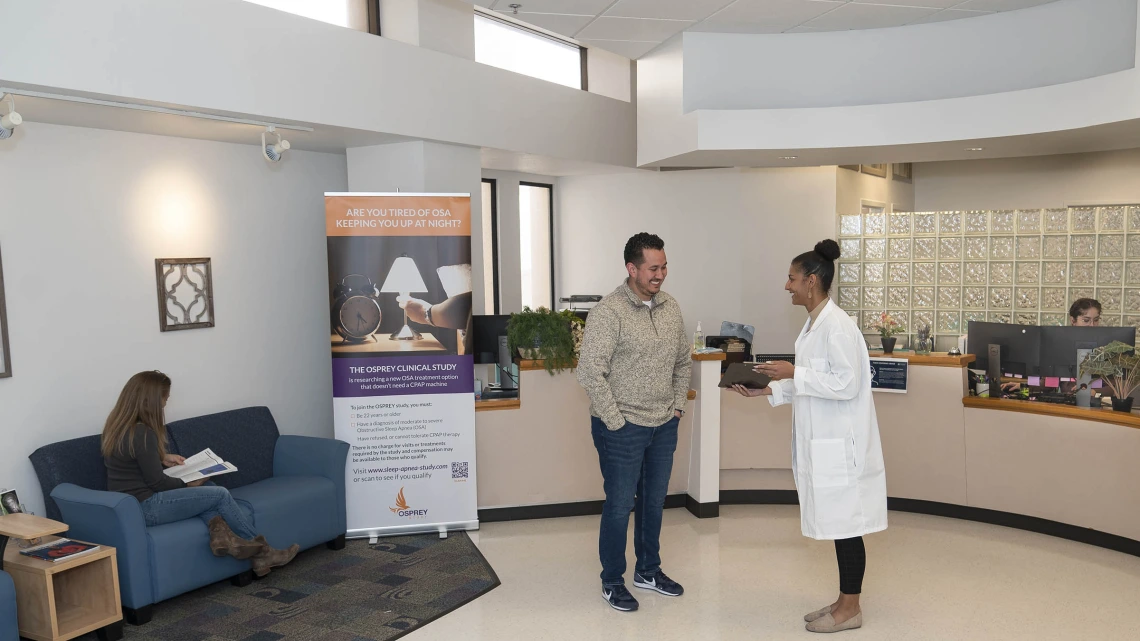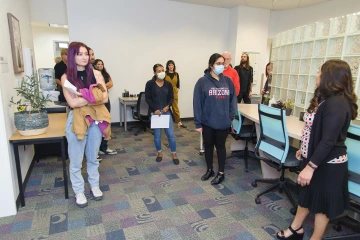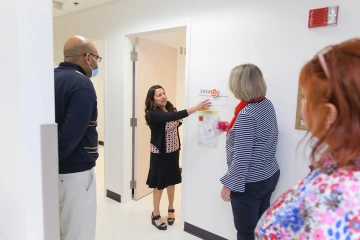CATS Center opens modernized, larger facility
UArizona Health Sciences Clinical and Translational Science Research Center doubled its size and increased research capacity with new space.

The reception area at the new University of Arizona Clinical and Translational Sciences Research Center is large, modern and filled with natural light — all improvements over the center’s old space.
Ask any University of Arizona Health Sciences researcher about their experiences working with the Clinical and Translational Sciences Research Center, and you’re likely to get a response similar to the one Elizabeth Connick, MD, of the UArizona College of Medicine – Tucson shared: “CATS is GREAT!!” – complete with two exclamation points.
So, what could be better than CATS? The answer is twice as much CATS. That is because the newly renovated space has doubled the size of CATS’s former home – from about 3,000 square feet to over 7,000.

Maria Gordon, senior manager of clinical research at the UArizona Clinical and Translational Sciences Research Center and Fayez Ghishan, MD, medical director for the center and pediatrics department head at the UArizona College of Medicine – Tucson, enjoy the grand opening event for the center’s new facility.
“The new state of the art CATS facility will serve the investigators at UArizona Health Sciences well and greatly improve clinical and translational research,” said Fayez Ghishan, MD, CATS medical director and pediatrics department head at the College of Medicine – Tucson. “I am very pleased with this new center and excited at the opportunity to continue quality research at this institution.”
Maria Gordon, senior clinical research manager for CATS, said the mission of the CATS Research Center is to provide facilities, dedicated staff and expertise to support clinical research.
“We are a shared resource that was established in 2008 to support faculty and staff of all UArizona Health Sciences colleges,” Gordon said. CATS provides support in three ways:
- The CATS team can manage an entire trial from start to finish. They assign a coordinator to manage the participant portion, data collection and entry as well as specimen collection, processing and shipping.
- They can provide clinical support to a primary investigator who has a team, but needs someone to perform the blood draws, vitals, electrocardiograms and other tests. They have registered nurses on staff who can do infusions and provide emergency backup to the study team.
- The CATS team provides the space and resources for the research teams to use and provide backup to the external study team if needed.
“CATS has been and continues to be invaluable to my research,” said Dr. Connick, who is the infectious disease division chief and professor at the College of Medicine – Tucson. “It provides not just research space and facilities, such as phlebotomy, but also research staff. The staff are well trained and extremely reliable and helpful. Maria Gordon is the genius behind the operation. She understands how to implement research protocols and is an innovator and problem solver. She is the key to the success of CATS.”
CATS, then and now
CATS opened on the first floor of the UArizona Cancer Center in 2008 with 11 studies. The center now has about 80 open studies each month with the capacity for more in the new space. While the old space had 14 exam rooms, the new facility on the third floor of the College of Medicine – Tucson has 16 exam rooms dedicated to adults and 5 for pediatric patients. CATS currently has 19 staff members, but with the increased capacity they are likely to grow.

Visitors pause in a common area during their tour of the new 7,000 square foot UArizona Clinical and Translational Sciences Research Center.
“The new facility is much more conducive to research for patients,” said Franz Rischard, DO, associate professor at the College of Medicine – Tucson. “Patients are much more comfortable in the larger, more modern space. The facilities are still in the hospital area, so inpatient and outpatient trials are easier to conduct. Maria Gordon deserves specific recognition in leadership, direction and ambition. CATS has been successful because she has spearheaded its growth and development.”
Gordon, who was hired to help create CATS, said her team works with UArizona Health Sciences Research Administration in the Office of the Senior Vice President, Michael D. Dake, MD, to open, support and conduct clinical trials for researchers throughout Health Sciences. She credits Dr. Ghishan; Lauren Zajac, associate vice present of Research Administration; and David Elmer, associate vice president of Health Sciences, with making the new facility for CATS possible.
“Dr. Ghishan, Lauren Zajac and David Elmer were instrumental in getting the new space for CATS,” Gordon said. “It was actually our participation in the UArizona Antibody initiative during the pandemic that highlighted our important contribution to the research community and that our current location was not ideal.”
Real-world impact

Gordon points out the red and blue wildcat paws outside an exam room to indicate the type of room during a tour of their new facility.
Dr. Connick notes another pandemic research win due to the CATS team. “During the early stages of the pandemic we had the opportunity to conduct a multisite trial looking at the impact of the Moderna vaccine on rates of infection in college students,” explained Dr. Connick. “This was a large study and CATS rapidly flexed up to provide us the research staff necessary to do this. Ultimately, the University of Arizona was the third highest recruiting site out of approximately 50 sites across the U.S. This would never have been possible without CATS.”
Dr. Rischard, who has conducted more then 50 clinical trials with the support of the center said, “I would not be able to conduct successful research without CATS.”
Fortunately, the appreciation between researchers and CATS is mutual. “I love helping the researchers make their projects happen,” said Gordon. “I have had the privilege to work with so many people and see so many projects from the idea phase all the way to completion. It is very rewarding work.”
Clinical and Translational Sciences Research Center services
The CATS Research Center offers a wide range of resources and services to accommodate the needs of research studies or patient visits. All CATS services are available for a fee and as resources permit.
- Exam rooms
- Consenting
- Infusion rooms
- Recruitment assistance
- Phlebotomy
- PK monitoring
- Specimen processing and/or shipping
- EKGs
- IV administration for infusion therapies
- Study coordination

